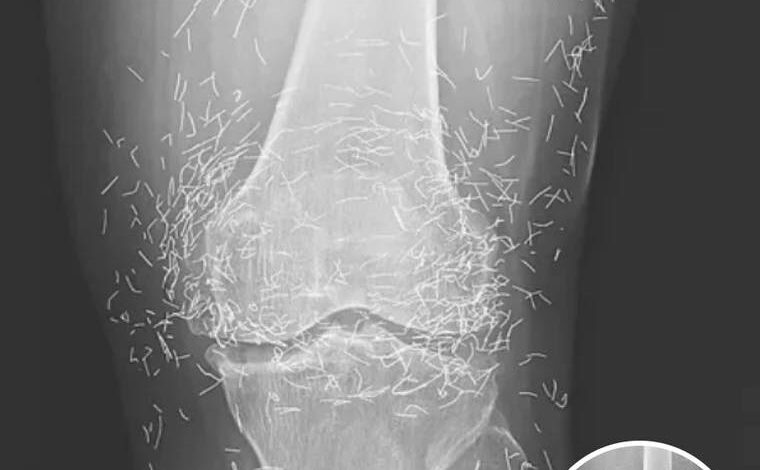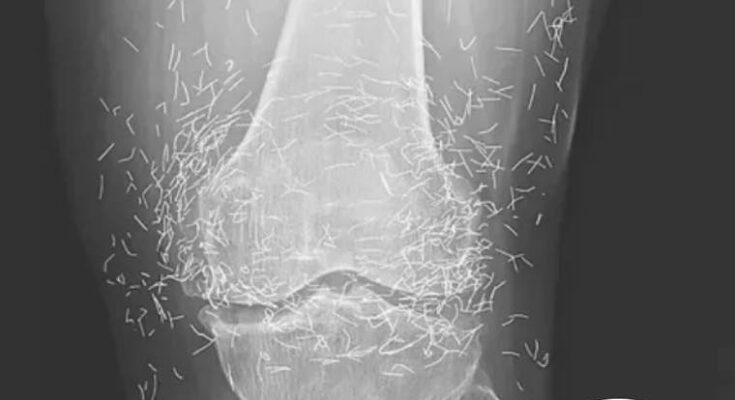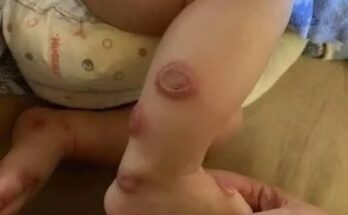
When doctors reviewed a routine X-ray of a 65-year-old woman suffering from chronic joint pain, they expected to find the usual signs of osteoarthritis—bone erosion, cartilage loss, maybe some swelling. What they didn’t expect was a glittering cluster of metallic fragments embedded deep in her knee tissue. On closer inspection, the images revealed hundreds of tiny gold needles.
The discovery left the medical team stunned. The woman, a South Korean patient who had struggled with severe osteoarthritis for years, had no recent surgeries or implants. But her medical history provided the missing piece of the puzzle: she’d been undergoing long-term acupuncture therapy.
A Desperate Attempt at Relief
Osteoarthritis is a degenerative disease that wears away the protective cartilage between joints, causing stiffness, swelling, and excruciating pain. For millions around the world, it’s a daily battle that turns simple tasks—like walking or climbing stairs—into painful challenges.
Like many patients, the woman had tried the standard treatments first: painkillers, anti-inflammatory drugs, and joint injections. But the side effects were brutal. Her stomach couldn’t tolerate the medication, and her pain persisted. Looking for alternatives, she turned to acupuncture—a traditional Chinese therapy practiced for thousands of years.
At first, it seemed to help. But over time, her acupuncturist introduced a variation of the treatment that promised “continuous healing” and “long-term pain relief.” Instead of removing the needles after each session, the practitioner inserted gold ones beneath the skin, leaving them there permanently to provide constant stimulation.
The Gold Needle Controversy
In South Korea, this method isn’t as rare as it might sound. Known as “permanent acupuncture” or “gold thread therapy,” it’s used by some practitioners to treat chronic pain, arthritis, and even cosmetic conditions like sagging skin. Thin strands of gold, often no thicker than a hair, are implanted into tissue to supposedly enhance blood circulation and energy flow.
However, the medical community remains skeptical. While some patients swear by it, scientific evidence supporting these claims is scarce. What is well-documented are the risks.
Dr. Ali Guermazi, a professor of radiology at Boston University who reviewed the case report but was not directly involved, expressed concern over such procedures. “The human body doesn’t like foreign material,” he explained. “It responds with inflammation, scar tissue, and sometimes infection. In cases like this, what starts as an alternative therapy can lead to long-term complications that are far worse than the original condition.”
A Hidden Danger Beneath the Skin
The X-ray images published in the New England Journal of Medicine showed dozens—possibly hundreds—of fine gold needles clustered around both knees. Some were deeply embedded in muscle tissue, while others rested just under the skin.
While gold is a non-reactive metal, the problem lies in the body’s defensive response. Over time, even inert materials can trigger inflammation as the immune system attempts to isolate the foreign objects. In severe cases, this leads to abscess formation or tissue hardening, both of which can worsen mobility and pain.
Another concern, Guermazi added, is that metallic fragments in the body can interfere with medical imaging. “Needles like these can distort X-rays or CT scans,” he said. “And MRIs are out of the question. The magnetic force could cause the metal to shift, potentially puncturing tissue or blood vessels. It’s extremely dangerous.”
The Allure of Alternative Medicine
Despite such warnings, acupuncture and related therapies remain immensely popular throughout Asia and beyond. In South Korea, gold thread implants are sometimes advertised as rejuvenating treatments that can reduce pain and improve circulation. Many patients—especially the elderly—see them as a last resort after traditional medicine fails.
The practice has spread to Western countries too. According to the National Institutes of Health, roughly 3 million American adults and 150,000 children had received acupuncture treatments as of 2007. While most sessions involve temporary needles that are removed afterward, a small but growing number of clinics offer semi-permanent or “microthread” implants as part of cosmetic or pain-relief programs.
But doctors continue to caution against unregulated procedures. “What’s often missing is oversight,” Guermazi said. “Inserting anything into the body—even something as seemingly harmless as gold—requires sterile technique and proper training. Otherwise, the risk of infection or injury increases dramatically.”
A Painful Lesson
In the South Korean woman’s case, the embedded needles were likely several years old by the time they were discovered. She had sought medical attention for worsening pain, assuming her arthritis was simply advancing. It wasn’t until her doctors ordered imaging that the true cause of her discomfort became clear.
Although there was no immediate life-threatening complication, the needles could not easily be removed without major surgery. In most cases, doctors prefer to leave such foreign bodies alone unless they are causing acute symptoms. Attempting to extract them risks damaging nerves, blood vessels, and surrounding tissue.
Instead, the woman was advised to stop any further implant-based acupuncture treatments and focus on safer management methods. Her case has since become a cautionary example among both physicians and patients—a reminder that even “natural” treatments can have unintended consequences.
Why People Take the Risk
So why do people continue to seek out such procedures despite the dangers? Experts say it comes down to pain, hope, and trust. Chronic pain patients often feel abandoned by mainstream medicine. When conventional treatments fail, they turn to anyone promising relief, even if it means crossing the line between therapy and risk.
Acupuncturists who use gold threads argue that the method works by keeping the body’s “energy channels” open. Western doctors, however, view this explanation as pseudoscience. The placebo effect—combined with cultural belief and personal experience—can create a powerful sense of improvement, even if the underlying condition doesn’t change.
Still, cases like this highlight the importance of informed consent. “Patients should always know exactly what’s being placed in their bodies,” said Guermazi. “Permanent implants, especially those made of metal, should be treated with the same caution as surgical devices. If your practitioner can’t provide scientific evidence of safety or approval by medical authorities, that’s a red flag.”
Lessons for the Future
The South Korean woman’s story has sparked renewed debate about alternative medicine’s place in modern healthcare. While acupuncture has been shown to provide modest pain relief for some conditions, experts emphasize that it should complement—not replace—evidence-based treatment.
Even traditional acupuncturists agree that leaving needles permanently embedded is risky. “True acupuncture is meant to stimulate, not implant,” said Dr. Kim Seong-ho, a licensed practitioner in Seoul. “The body heals through balance, not by trapping foreign materials inside.”
A Glimmering Reminder
As for the woman whose knees now sparkle faintly under X-rays, her story stands as a stark warning wrapped in good intentions. What began as a search for healing turned into a medical anomaly—one that radiologists around the world now study as an example of how ancient practices can clash with modern science.
In her own words, she told doctors she had simply wanted relief. “I just wanted to walk without pain,” she said. “I didn’t think gold could hurt me.”
Her X-rays, gleaming with hundreds of tiny metallic slivers, now serve as a haunting reminder that not all that glitters is gold—especially when it’s buried beneath your skin.



